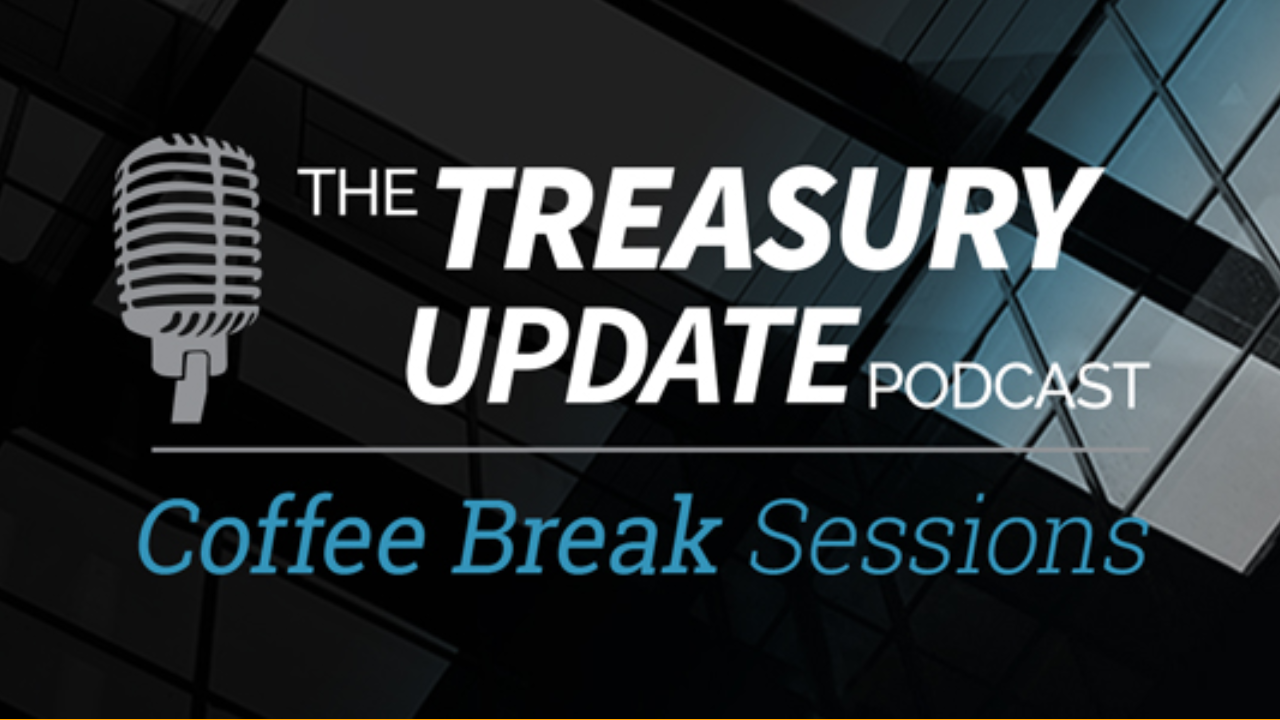
Session 14
What are Debt Instruments?
What are debt instruments? Coffee Break Session Host Alexa Cook catches up with Strategic Treasurer’s Senior Consultant Melody Hart to discuss a high-level overview of debt instruments. They define debt instruments, its counter parties and different considerations for debt. Tune in and learn a little bit about debt instruments.
Host:
Alexa Cook, Strategic Treasurer


Speaker:
Melody Hart, Strategic Treasurer


Episode Transcription - CBS Episode 14: What are Debt Instruments
Alexa:
Hey guys, welcome to the Treasury Update Podcast Coffee Break Session, the show where we cover foundational treasury topics and questions in about the same amount of time it takes you to drink your coffee. This is your host, Alexa. And today I’m joined again with Melody Hart, who is a consultant at Strategic Treasurer. And today’s topic is what are debt instruments? So thank you for joining me today, Melody.
Melody:
Thank you, Alexa.
Alexa:
Yeah, so let’s jump right into it. What are some typical types of corporate debt? And I guess, what are debt instruments?
Melody:
Okay, so well, debt instruments, first of all, are borrowing of money from an investor, or bank, or someone who is willing to lend. There are several types that … Well there’s many, many types of debt, and I’m not going to go into all of them, because most of them are not … There’s many that are not really used very often. But for common forms, there’s debentures, and those are typically used for short-term capital to fund a revenue stream, like a revenue generating project. And those are usually repaid with the revenue from the project. There’s no security underlying these instruments. You really have to rely on the underlying credit. Those are not that common in corporations though.
Melody:
Bonds are very common in corporations. They’re typically backed by the assets of the company. They’re issued at market value. What that means is if you’re going to borrow $1,000, and you issue a bond for $1,000, obviously a company would be issuing one much higher. But let’s say you were going to buy an individual bond, because it’s at market value, depending on what the rate is that’s set for the instrument, you might determine that … The market might say, “Oh, we think that the rate is a little low, so therefore, we’re going to pay you less for the bond.” So they would pay maybe, $990 for a $1,000 bond, which means that when they get repaid for the bond, they get the $1,000, but they give the company the $990. So that ups the return for the investor. Likewise, if the rate is viewed favorably, it could sell at a premium instead of a discount, and be like $1,010 that they’d pay for it. The company doesn’t get exactly $1,000 for a bond. It gets whatever the market says it’s worth. Although they’d still have to repay the $1,000.
Melody:
There’s also convertible bonds, which can be converted from debt into equity under certain circumstances, often it’s maybe share price that may trigger it, or other things they could have to trigger it.
Melody:
And another type of bond is a private placement. Those are issued only to sophisticated investors, usually large banks, or mutual funds, or it could be insurance companies. So these bonds are not traded on the exchange. They’re placed privately with these banks, and mutual funds, et cetera.
Melody:
Loans are issued to a counter party, such a bank or an individual, and they can be term loans. Term loans are paid over the time of the loan, and has to be repaid. There’ll be payments, like every six months. You have to repay it and you cannot reborrow it. Or, it can be a revolving credit, which that allows you to borrow, repay, borrow again multiple times during the tenure of the agreement. Loans can be bilateral with one bank. They can be club deals with a select small group of lenders, or they can be syndicated loans with the larger number of lenders. They can be secured or unsecured, depending on the credit of the company. Asset backed loans are typically backed by receivables and inventory. The amount that can be borrowed on them is often dependent on a calculation regarding the amount of collateral coverage of these assets there are. So that allows the company with a less than stellar credit rating to receive more favorable pricing, because the loan rate is based on the credit of the receivables of their customers, and the liquid value of the inventory.
Melody:
Another form that’s very common is a securitization. Securitization is a lending program whereby the company puts in place a special purpose entity that’s bankruptcy remote, and then it sells those into that bankruptcy remote entity. It puts the receivables in there, and then the company can borrow at a lower rate based on the risk pool of the receivables. And if anything happens with company, the receivables are in that bankruptcy remote entity.
Melody:
Another very common one, but only common if you are investment grade, a high investment grade company, is commercial paper. And this is short term revolving type lending, and are unsecured. You go out and issue a commercial paper for a certain time period that you want, and the rate is market driven. And then you repay, and you then can issue another note. So this is a … It’s usually rated A1P1 or A2P2. So, these are rated securities that are very commonly used. But there can be issues in the market. Sometimes there’s been disruptions in commercial paper markets. And you always … When you issue commercial paper, you would need a backstop facility. It’s required. So you would have revolving credit beneath that, that would be available to draw on if something happened to the commercial paper market.
Alexa:
Okay, just in case. So just to recap what those types were. debenture has bonds, loans, securitizations, and commercial paper, right?
Melody:
Yes.
Alexa:
Perfect. And then when you’re doing these types of debt instruments, who are these with, or who are the counterparties that these debt instruments are taken out with?
Melody:
Well, with commercial paper, bonds, or debentures, your counterparties are usually investors. They can be individual investors. They can be large investors, like mutual funds. Anyone who is an investor can buy those. On bonds, investment banks help you issue them, and help to sell it through. That’s true of debentures, too. But if it’s a tough sell, it’s possible to pay underwriting fees that the bank takes all of the risk of issuance, and may be forced to buy all the bonds, and then sell them in the secondary market. It’s a very expensive, very, very expensive proposition to do this, which is usually only exercised when obtaining the full amount is imperative, and the market for the company’s bonds is not there. Otherwise, you would be selling it regularly, not with an underwriting. For loans and securitization, your counterparties are usually banks. But in some cases, if it’s a really large syndicated loan, they will include banks, hedge funds, insurance companies, et cetera. And that’s particularly true when the credit rating is not as good.
Alexa:
Okay. So I guess in short, the counterparties are either, I mean most typically, investors or banks, right?
Melody:
Yes.
Alexa:
Okay. And then what are some of the key considerations on why you would choose one type of debt over another?
Melody:
Well, a number of considerations of what you’d choose. But one of the key considerations is the credit of the company. Commercial paper, and unsecured loans, and bonds are utilized when the company has high credit quality. And you can still use bonds with poor credit quality, but it’s going to be highly secured. Security is a way that either the assets of the company, like a secured loan, or a securitization, or asset-based, use other credits, those are used when your credit is not so good. It gets you a lower rate, if you’re using the assets of your customers, if they have good ratings, and the risk pool is good, otherwise your rate could go up. If you have security, of course, that lowers your rate, and plus, it’s probably going to be required by the banks, and by the investors.
Melody:
The second consideration is the cost. So, if you’re investment grade, you don’t have to use your assets or other people’s credit, and usually can get very favorable rates. But if you’re not, you have to determine the cost. And if the cost is too high, then you have to move into other things, like asset-backed and securitizations, if you can’t get the financing at the costs you need. Private placement would be … That’s usually a very high cost, and that’s what you would have to do if you can’t get any of the others.
Melody:
Another consideration is the availability. There are times when financing is more available than others. If I think back to 9/11, I was at a company, and we were in the process of getting ready to issue a European bond. And when 9/11 happened, the market just fell apart, and we couldn’t issue. We had to wait until the market got better. And something similar was true when I was at a company during the last recession is the market falls apart, and you have to see what is available, and you might have to change what you’re going to issue just to be where the market is. So if it’s relatively unavailable or difficult, then you might have to turn to underwriting or private placement. But those are obviously more apt to be used with poor credit as well.
Melody:
And growth is another factor. If a company is high growth and doesn’t have great credit or is high risk, they might wish to utilize a convertible. That will lower their rate, because it’s more marketable to investors, because they have an opportunity for greater returns if the bond becomes convertible to equity.
Alexa:
So I guess to recap everything that we’ve covered today, we’ll start with what a debt instrument is. So, that’s tools that are used by different entities for the purpose of obtaining capital, or I guess, running your operations. There’s lots of different types of those, but I think you said bonds were the most common. There’s going to be counterparties or issuers when you are using debt. And so, those are typically investors or banks. And then the key consideration for debt selection is going to be the company’s credit. Is there anything else you want to add?
Melody:
I would say that bonds are common, but probably the most common is revolving loans.
Alexa:
All right. Well, thank you, Melody. And to all of our listeners, make sure you tune in every first and third Thursday of the month for a new Coffee Break Session. And as always, we love to hear from you, so please reach out with comments, questions, topics at Podcast@StrategicTreasurer.com. Thanks, everyone.
OUTRO:
This podcast is provided for informational purposes only, and statements made by Strategic Treasurer, LLC on this podcast are not intended as legal, business, consulting, or tax advice. For more information, visit and bookmark StrategicTreasurer.com.
Related Resources
Want access to more great content? Subscribe to Strategic Treasurer on YouTube!
A part of the Treasury Update Podcast, Coffee Break Sessions are 6-12 minute bite-size episodes covering foundational topics and core treasury issues in about the same amount of time it takes you to drink your coffee. The show episodes are released every first and third Thursday of the month with Special Host and Treasury Consultant Alexa Cook of Strategic Treasurer.




